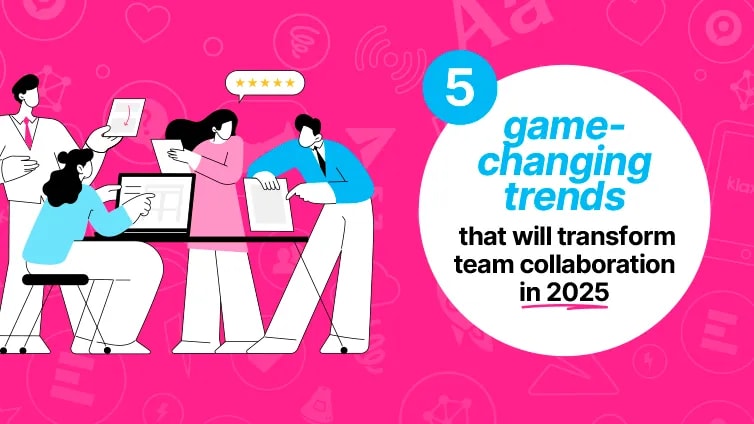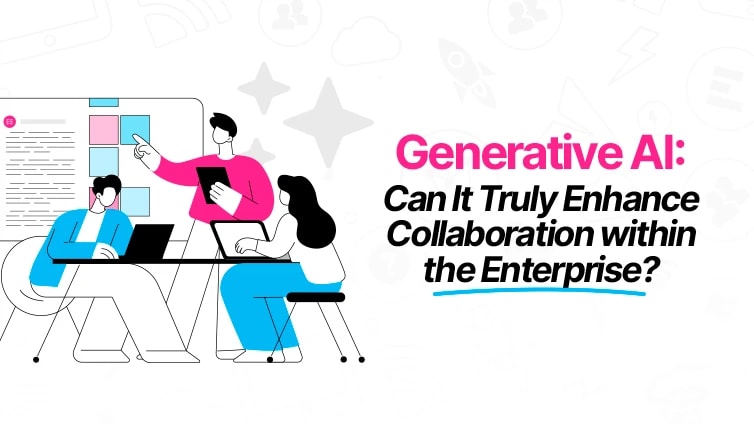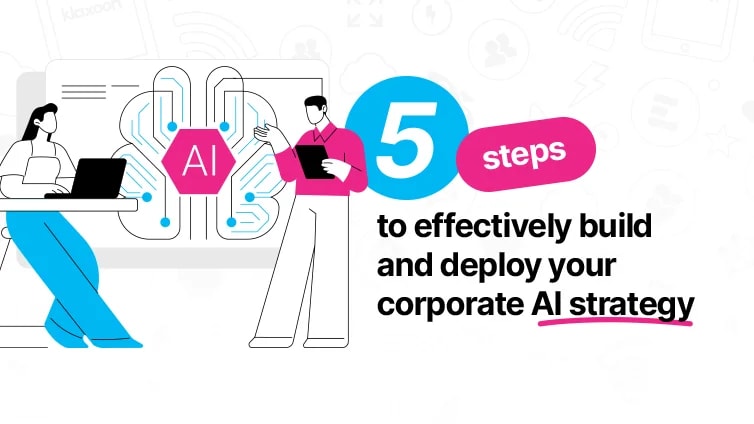Artificial intelligence: 6 examples of how it can save you time at work
Executive summary:
As time becomes an increasingly valuable business resource, artificial intelligence (AI) is establishing itself as an essential ally.
However, how can AI transform our daily work lives beyond automation? All too often, companies are content to use AI merely to speed up existing processes, without fundamentally rethinking their practices.
The key? Explore the uses of AI that go beyond automation to save time where you least expect it, giving new meaning to your workday. By adopting an experimental approach and actively involving your teams, you can transform collaboration, learning, and well-being at work in a lasting way.
Here are six concrete ways to achieve this:
- Limit information overload: Use AI to filter, prioritize, and summarize the essentials, so you can regain your focus and avoid information overload.
- Ttransform your workflows: Analyze and simplify your processes with AI to eliminate unnecessary tasks and focus on what really matters.
- Reveal biases and improve decision-making: Use AI to detect blind spots and diversify perspectives, thereby strengthening the reliability of your collective decisions.
- Improve work experience: Experiment with AI to streamline communication, anticipate the needs of your teams and customers, and personalize their experience.
- Train faster: Accelerate skills development with personalized learning paths and AI-enabled knowledge transfer.
- Enhance well-being at work: Detect signs of overload or fatigue and encourage new practices that promote balance and quality of life at work.
By rethinking the use of AI from these angles, every company can save time... and, above all, make that time better spent.
In our daily work, we spend our time chasing after time. A study by Pryon shows that almost half of professionals spend 1 to 5 hours a day just searching for information.
In response to this, optimization tools are multiplying, and artificial intelligence (AI) is often presented as the miracle solution for automating repetitive tasks and boosting our productivity. But what if AI could also help us save time in other ways?
Beyond its promises of efficiency, AI can be used differently to add value where we least expect it:
- Filtering information noise;
- Identifying duplicates and unnecessary tasks;
- Revealing our cognitive biases;
- And even help us maintain our well-being at work.
According to a report by Accenture, generative AI is more than just a technology. It is an opportunity to transform our working practices in a sustainable way.
That said, there are still areas where AI will never be able to completely replace us. Collaboration, creativity, and quality of life at work are all deeply human topics. Therefore, our discernment is essential in determining when AI becomes an asset or an obstacle to effective collaboration.
With these observations in mind, let's discover six unexpected uses for AI that, far from being limited to automation, are profoundly transforming our relationship with time and collaboration.
1. AI to limit information overload (instead of producing more of it)
One of the main paradoxes of our time is that the tools that are supposed to save us time often contribute to information overload. Every day, we send and receive an average of 376 emails at work, and it is estimated that this number will reach 408 emails per day by 2027!
In addition to emails, we also have to deal with notifications, shared documents, chat messages, the company’s intranet, and more. All of this generates a tsunami of information that slows down our productivity and hinders our concentration and well-being at work.
This is where well-designed AI can make a difference: not by generating more content, but by helping you filter, prioritize, and declutter your digital environment. More and more tools are now natively equipped with features that meet these objectives:
- Provide a summary of a conversation or project history;
- Group your ideas by theme;
- Automatically sort your emails according to their importance;
- Hide non-urgent messages to reduce background noise, etc.
Beyond simply saving time, this approach also helps restore the quality of attention: fewer unnecessary distractions, more room for reflection and perspective.
It also invites us to rethink our relationship with information: do we really need to read, process, and archive everything? Could Pareto's law also apply in this case? 80% of the information we receive would only contribute 20% to our final understanding of a subject.
By helping us identify and extract what really matters, AI becomes an ally in reconnecting with a more controlled consumption of information.
2. AI to transform your workflows (and eliminate the unnecessary ones)
We often think of AI as a technology designed to speed up or automate each individual task or action. However, its real strength may lie in its ability to challenge our overall habits and identify the superfluous elements in our workflows.
According to the 2024 Impactful Work report, employees estimate that almost half of the work they do has no real impact. This clearly shows that a significant portion of our time is taken up by low-value tasks such as redundant reporting, multiple approvals, and administrative follow-ups that pile up without any real justification.
This is where AI can play a decisive role, not only by optimizing your work processes, but also by helping you think about them differently:
- Map the time you spend in meetings;
- Identify duplicate topics or tasks;
- Identify overloaded schedules or team rituals that no longer add value;
- Analyze your internal workflows to detect unnecessary steps, etc.
In a context where work overload is often related to the accumulation of tasks rather than their necessity, the ability to sort through and question the status quo is invaluable. AI then becomes a powerful lever for daring to say no, with supporting arguments, and lightening schedules for what really matters: reflection, creativity, and collaboration.
3. AI to reveal biases (and improve collective decision-making)
AI is often associated with rapid analysis or the ability to process large amounts of data. However, it can also become a valuable tool to help us identify our own judgmental flaws or cognitive biases as humans, which can hinder the quality of collective decisions.
In business, strategic decisions are often shaped by habits, intuition, and group dynamics, sometimes at the expense of objectivity.
In such a context, what actions can be taken using AI to help teams take a step back and look at their own reasoning?
For example, some AI tools are able to analyze exchanges during meetings or brainstorming sessions to detect recurring patterns:
- Dominance of certain profiles in discussions;
- A tendency toward uniformity of opinion (conformity bias);
- Omission of minority viewpoints, etc.
AI can also cross-reference data from different departments to highlight inconsistencies or weak signals that would go unnoticed on a human scale.
By facilitating the detection of these biases, it does not replace human judgment, but provides critical feedback that helps teams question themselves, diversify their sources of information, and improve the quality of their exchanges. Rather than imposing a single truth, AI encourages questioning and coming up with more reliable and sustainable collective decisions.

Discover the 5 key team collaboration trends that will transform your organization’s engagement and effectiveness in 2025.

4. AI to improve work experience (for both customers and employees)
Beyond our operational workflows, artificial intelligence can also help us develop a better vision of our work experience, whether it be the employee experience or customer experience.
We already know that these technologies can help personalize customer journeys (tailored recommendations, chatbots, predictive needs analysis, etc.). But what is less well known is that AI can also be used to accelerate engagement and boost performance internally.
In both cases, the key lies in experimentation. It is not about applying AI uniformly, but about testing, adjusting, and observing the concrete effects on the experience, whether for your customers or employees.
AI can therefore be used at different levels:
- Streamlining communication;
- Anticipating needs;
- Detecting weak signals of satisfaction or dissatisfaction, etc.
Giving AI a variety of roles can also reveal unexpected uses: analyzing emotions through customer or employee feedback, optimizing your workspaces, etc. The key is to adopt an open mindset, accepting that some trials will be more successful than others, and actively involving your audience in evaluating the results.
In short, AI is becoming a field of continuous improvement, where every company can test and deploy its own levers for improving the work experience. This is how you can more quickly create a truly differentiating experience for both your customers and your employees.
5. AI for faster training (and progress without even realizing it)
Another often underestimated benefit of AI is its ability to help us learn faster and share our knowledge more effectively.
According to a 2024 study, the first thing 89% of learners look for in training is personalization (CYPHER Learning). By analyzing each employee's background, needs, and preferences, AI-based e-learning platforms can offer them tailored content adapted to their level and pace.
As a trainer or manager, you can say goodbye to generic, time-consuming training courses. AI identifies the skills that need to be strengthened in your teams, recommends targeted modules, and adjusts each person's learning path in real time based on their progress.
Furthermore, artificial intelligence facilitates on-the-job training, beyond formal training initiatives. For example, it can act as a virtual assistant to answer your teams' various questions, or help them quickly find a file or contact in your internal database.
In addition, some AI tools can detect skills development needs before they are even expressed by analyzing job changes, new projects, or industry trends. This promotes continuous learning that fits naturally into the daily work routine. As a result, everyone progresses at their own pace, without feeling like they are “wasting time” on training, and the company gains agility and responsiveness on these issues.
6. AI to enhance well-being at work
Quality of life at work has become an essential criterion for engagement and sustainable performance.
In a professional environment where demands are constant and where the balance between personal and professional life is sometimes difficult to maintain, employees' expectations are also changing. They are looking for working conditions that promote not only efficiency but also well-being on a daily basis.
Recently, artificial intelligence has shown that it can also be one of the tools contributing to this dynamic in an innovative way. By analyzing work habits, activity patterns, and interactions within teams, certain AI tools are able to detect signs of overload, fatigue, or disengagement:
- Increase in messages outside normal working hours
- Decrease in participation in discussions
- Accumulation of urgent tasks, etc.
These analyses enable preventive alerts to be issued, but also propose personalized adjustments: suggestions for breaks, reorganization of priorities, or recommendations for better distribution of the workload.
Beyond simple prevention, AI (like certain collaborative tools) can also encourage new practices that promote well-being:
- Planning moments of deep focus
- Raising awareness about disconnecting
- Creating anonymous listening spaces to gather team feedback, etc.
Far from replacing humans, it becomes a support tool that helps everyone find a more harmonious balance between performance and quality of life. In this sense, AI can help pave the way for a more attentive, respectful, and humane way of working.
Conclusion
The potential of artificial intelligence extends far beyond automation. It is a catalyst for significant changes in our professional practices. By helping us filter information, rethink our workflows, reveal our biases, enrich the work experience, accelerate skills development, and promote well-being, AI opens up new opportunities to save time... and make better use of it.
However, its effectiveness will always depend on our ability to integrate it wisely while keeping people at the center. Only then will AI become a valuable asset for tomorrow's companies.
Unlock your teamwork potential
For free, make your first steps to top-tier work efficiency with the Klaxoon Work Collaboration Platform.

